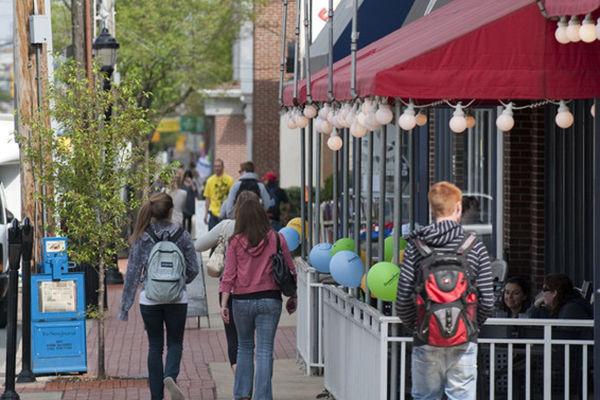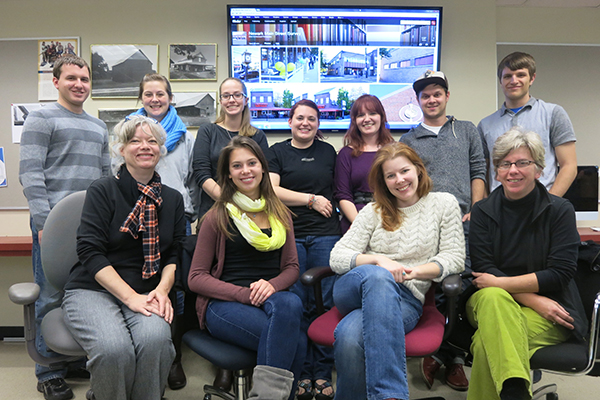


Focus on history
UD students help Newark document historic buildings with photography
1:25 p.m., Nov. 11, 2013--Some say a picture is worth a thousand words.
But to a class at the University of Delaware and the city of Newark, a picture can be worth a lifetime of historic preservation.
Campus Stories
From graduates, faculty
Doctoral hooding
In David Ames’ architectural photography course, a team of graduate and undergraduate students is photographing historic buildings on Main Street. They have joined with city planners to help document what’s there for survey, design, promotion and preservation.
On a recent blustery day, junior Jessica Lang and senior Marek Jaworski strolled down Main Street photographing the buildings on their list. They were supposed to focus on capturing one primary detail of each building -- starting at the Post Office and ending at the former Marine Corps recruiting building -- and one perspective shot.
“We look for things like a balcony, designs on a railing to tell the types of buildings, and where it is, to preserve the history of the building,” Lang said.
The class was divided into five teams of two, said Ames, professor and director of UD’s Center for Historic Architecture and Design, part of the School of Public Policy and Administration. Each team was armed with a list of buildings to document, and once old Main Street was complete, the class moved on to East Main Street and Old Elkton Road.
“They’re having fun,” Ames said. “It’s part of the learning process. It motivates them. They know it’s more than just an exercise.”
Years ago, Ames worked with the city to help conduct a survey of Newark’s historic buildings. But the city didn’t keep it up-to-date, said city planner and Downtown Newark Partnership administrator Ricky Nietubicz. Ames said the technology used at the time was outdated, anyway.
This year, the Newark planners approached Ames to see if he wanted to help do it all over again. Ames was willing and eager to give his students a real hands-on experience, and decided to use Flickr as a database and warehouse for the photos.
By using the online photo-sharing site, the city has access to the photos during every step of the process, even before Ames’ students are finished. Photos can be manipulated, tagged, classified and quickly surveyed. They can also be shared.
On a recent afternoon, Ames and members of the class sat down to look at the first round of photos. He asked whether they had fun.
Students spoke up: “Cars and people make it hard.”
“Obstructions are hard to photograph around.”
“The time of year is tough; there’s no light exposure.”
The class is, first and foremost, a material culture photography class. The students first learned about historic architecture. Then they learned how to use their digital cameras, how to achieve the desired lighting, how to frame their shots.
Then they learned what elements of a building are necessary for documenting historic buildings, usually a detail that defines the building or an elevation or perspective shot.
Ames went through each team’s photos with the class, listening to their experiences and how they chose the photographs that ended up on the Flickr page. He gave them tips about framing, lens choice and their use of perspective.
As the students talked about their photographs, Nietubicz weighed in. He explained a lot of people think most of Main Street is brick, but their photos demonstrated otherwise. He talked about the “new” Newark architecture, the false chimneys being added as architectural details and the cobblestone work in some new buildings.
The work Ames’ students are doing is invaluable, Nietubicz said. Their efforts work toward preservation, but also toward understanding what is already there, what elements unify the diverse buildings on the street and how the development of updated guidelines can influence future historic buildings.
“We can figure out where we are going based on where we have been,” he said.
The project is part of a larger Downtown Delaware program through the Delaware Economic Development Office, modeled after a similar national program. Newark has one of eight Main Streets in the state.
There are no “accidents” in the design of a unified place, Ames said. Often, people argue that new development of old spaces ruins the historic character. But the upper floors are usually left untouched. Ames believes the changes reflect how the street develops and evolves.
For many students, they were surprised to find the commonalities among Main Street’s buildings, even when they differed. The white marble and ornate floral columns on the M&T Bank Building are echoed in the Post Office, for instance.
Travis Olson, a first-year graduate student in historic preservation, said the project helped him engage with Main Street’s buildings, which had seemed cold to him before.
Nietubicz said the project was helping him take a step back from the buildings he sees day in and day out.
For the students “it’s an educational experience,” he said. “The students know what they are looking for and they have an eye for composition. They are not all from here and have a fresh perspective, a fresh set of eyes and talent.”
Ames said the hands-on experience is “stock and trade” for people who embark on career paths in historic preservation or in architectural photography.
“Our mission in public policy is research and education, outreach, training them for their career,” Ames said.
Lang and Jaworski don’t think they will pursue careers in historic preservation or even in photography. Both have enjoyed it as a hobby, they said, and found the class formative and exciting.
“It brings a whole new perspective to what’s cool about buildings, things you don’t look at in detail,” Lang said. “You notice all the old buildings on Main Street you never noticed before.”
On helping Ames and the city with a project larger than the class itself, Lang said, “It’s cool he gave us that responsibility.”
Article by Kelly April Tyrrell
Photos by Evan Krape and David Ames









